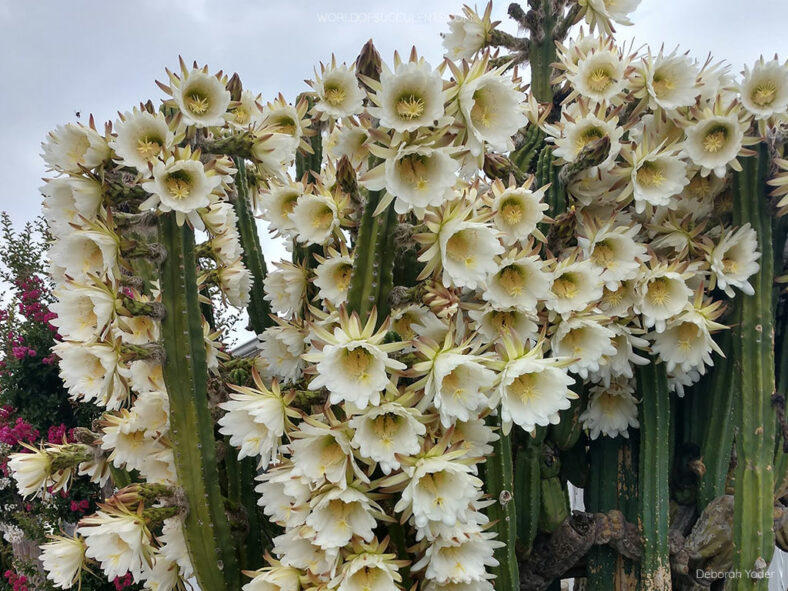Cereus is a genus of 34 officially accepted species of large columnar cacti native to South America. It is one of the oldest names in the family Cactaceae, described by Philip Miller in 1754. Until the 1920s, Cereus was used to describe any cactus with a very elongated body, including columnar and epiphytic cacti. Over 500 species previously classified in Cereus are now reclassified as separate genera.
Members of the genus Cereus are generally shrubby or tree-like columnar cacti with 4 to 10 well-defined ribs lined with rows of large areoles armed with several stout spines. Flowers are large, funnel-shaped, usually white, sometimes pink, purple, and rarely cream, yellow, or greenish. They are fragrant and nocturnal. The fruits of some species are edible. They are globose to ovoid, naked, usually red but sometimes yellow, with white or pink pulp. The seeds are large, ovoid, and glossy black in color.
The generic name "Cereus" derives from the Latinized form of the Ancient Greek "κηρός," meaning "wax, torch, or candle," and refers to the columnar shape of the plants.

Growing Conditions for Cereus
Most Cereus species are too large to grow indoors, but smaller and younger specimens can be kept inside until they mature.
Light
Cereus cacti like full sun. They can handle partial shade but thrive in direct sunlight during the summer. A sunny window is a good spot to grow a Cereus indoors. Rotate the pot a quarter turn every week or two to encourage balanced growth. Get your Cereus outdoors from spring to fall for fresh air and extra light, if possible. Increase sun exposure gradually to prevent sunburn.
Soil
These cacti do not like to have "wet feet" and must be grown in well-draining soil. Use commercial soil mixes for cacti or make your own potting mix.
Temperature
From spring to fall, Cereus cacti prefer hot temperatures between 70°F and 95°F (21ºC and 35ºC). In winter, temperatures drop to 50°F (10 °C). Most species are grown outdoors in USDA hardiness zones 9a to 10b, with temperatures ranging from 20ºF to 40ºF (-6.7ºC to 4.4ºC). However, elsewhere, you could bring your potted plants indoors for the winter.
General Care for Cereus
Most Cereus cacti are easy to care for and an excellent choice for beginners.
Watering
Water thoroughly from spring to fall during the active growth period, but allow the soil to dry out before watering again. With the arrival of fall, gradually reduce the watering frequency. When Cereus cacti are dormant in winter, give them just enough water to prevent shrinking.
Container-grown plants often require more water than their counterparts growing in open soil.
Fertilizing
During their growing season, Cereus cacti like regular fertilizing. A balanced, water-soluble fertilizer, diluted to 1/4 strength, can be added to each watering. A 10-10-10 fertilizer is ideal. Instead of making a solution of water and fertilizer, there are also dry fertilizers. They are applied to the soil surface or mixed with the soil when repotting. Do not fertilize during the winter.
Repotting
While Cereus cacti are young, it is recommended to repot them each year in early spring to provide fresh soil, inspect the root system, and move them to larger pots if necessary. Once they mature, repot when your cactus is outgrowing its pot. Knock away old soil, prune out any dead roots, then replace your Cereus in a new pot and backfill with fresh soil. Wait for a week or two before watering the repotted cactus.
How to Propagate Cereus
Propagation by stem cuttings is the easiest method for propagating Cereus, as seed propagation is a slow process.
Cuttings
Cut the top off a Cereus stem and lay the cutting on a paper towel in a dry location away from direct sunlight. Allow the cutting to callus for a week or two before placing it in a well-draining soil mix. Planting of the cuttings is best done when the cacti are actively growing.
Seeds
Growing Cereus from seeds is a process that requires considerable time and patience, but it is also one of the most rewarding experiences. Sow seeds over the top of the soil and gently press them into the soil. Keep the soil moist until the seeds germinate. Provide a consistent temperature between 70°F and 80°F (21°C and 26.6°C). Spring and summer are the best times to sow seeds.
Pests and Diseases of Cereus
Most problems associated with Cereus cacti are bacterial or fungal diseases caused by overwatering. They also get the occasional insect pest.
Pests
Scale, mealybugs, and root mealybugs are the most common pest problems for Cereus. Less common pests include spider mites and fungus gnats. These pests are difficult to control because they are small and excellent at hiding, making them hard to spot.
Diseases
If the roots have become dark brown or black and overly soft, the cactus could be experiencing root rot. Cut off the affected parts and replace the soil before replanting. Check carefully for black, dark brown, or reddish spots on the cut surface. They should not be there.
Toxicity of Cereus
Cereus cacti are non-toxic to humans or animals. However, the spines are sharp, so keep away from children and pets.
Links
- Back to genus Cereus
- Succupedia: Browse succulents by Scientific Name, Common Name, Genus, Family, USDA Hardiness Zone, Origin, or cacti by Genus